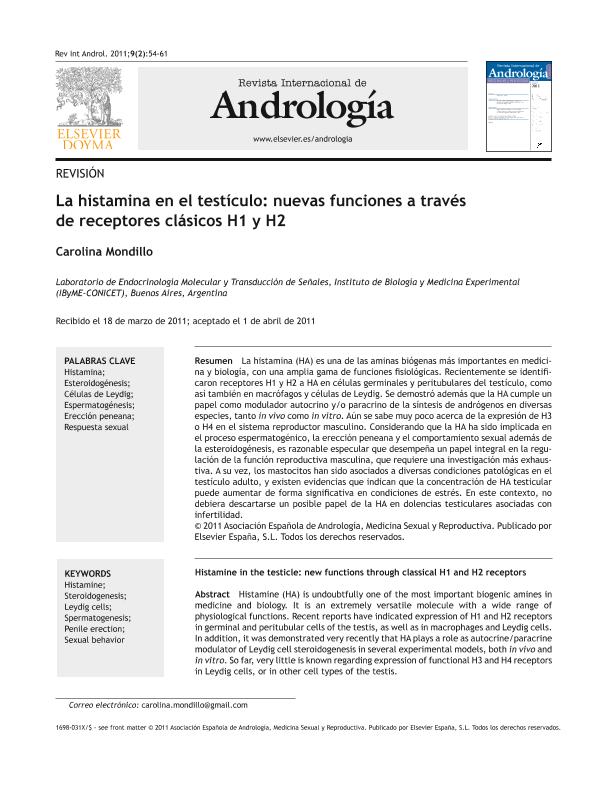Mostrar el registro sencillo del ítem
dc.contributor.author
Mondillo, Carolina

dc.date.available
2017-01-02T15:27:43Z
dc.date.issued
2011-04
dc.identifier.citation
Mondillo, Carolina; La histamina en el testículo: nuevas funciones a través de receptores clásicos H1 y H2; Elsevier; Revista Internacional de Andrología; 9; 2; 4-2011; 54-61
dc.identifier.issn
1698-031X
dc.identifier.uri
http://hdl.handle.net/11336/10670
dc.description.abstract
La histamina (HA) es una de las aminas biógenas más importantes en medicina y biología, con una amplia gama de funciones fisiológicas. Recientemente se identificaron receptores H1 y H2 a HA en células germinales y peritubulares del testículo, como así también en macrófagos y células de Leydig. Se demostró además que la HA cumple un papel como modulador autocrino y/o paracrino de la síntesis de andrógenos en diversas especies, tanto in vivo como in vitro. Aún se sabe muy poco acerca de la expresión de H3 o H4 en el sistema reproductor masculino. Considerando que la HA ha sido implicada en el proceso espermatogénico, la erección peneana y el comportamiento sexual además de la esteroidogénesis, es razonable especular que desempeña un papel integral en la regulación de la función reproductiva masculina, que requiere una investigación más exhaustiva. A su vez, los mastocitos han sido asociados a diversas condiciones patológicas en el testículo adulto, y existen evidencias que indican que la concentración de HA testicular puede aumentar de forma significativa en condiciones de estrés. En este contexto, no debiera descartarse un posible papel de la HA en dolencias testiculares asociadas con infertilidad.
dc.description.abstract
Histamine (HA) is undoubtfully one of the most important biogenic amines in medicine and biology. It is an extremely versatile molecule with a wide range of physiological functions. Recent reports have indicated expression of H1 and H2 receptors in germinal and peritubular cells of the testis, as well as in macrophages and Leydig cells. In addition, it was demonstrated very recently that HA plays a role as autocrine/paracrine modulator of Leydig cell steroidogenesis in several experimental models, both in vivo and in vitro. So far, very little is known regarding expression of functional H3 and H4 receptors in Leydig cells, or in other cell types of the testis.
Because antihistamine drugs target HA receptors, the novel role of HA as modulator of testicular steroidogenesis will surely attract more attention to possible unexpected side-effects of such drugs, which might alter the local balance and in turn enhance or decrease androgen production. In this regard, the more we know about HA receptors and their multiple functions, the more opportunity there will be for rational drug design.
Considering that HA has been implicated in spermatogenesis, penile erection and sexual behavior as well as steroidogenesis, it appears that the amine plays an integral role in the regulation of male reproductive function which certainly deserves further investigation. Of note, several reports have linked testicular mast cells with the pathogenesis of testicular disorders. Bearing this in mind, a potential role of HA in testicular pathology associated with infertility should also be evaluated.
dc.format
application/pdf
dc.language.iso
spa
dc.publisher
Elsevier

dc.rights
info:eu-repo/semantics/openAccess
dc.rights.uri
https://creativecommons.org/licenses/by-nc-sa/2.5/ar/
dc.subject
Histamina
dc.subject
Esteroidogénesis
dc.subject
Células de Leydig
dc.subject
Espermatogénesis
dc.subject
Erección Peneana
dc.subject
Respuesta Sexual
dc.subject
Histamine
dc.subject
Steroidogenesis
dc.subject.classification
Otras Ciencias de la Salud

dc.subject.classification
Ciencias de la Salud

dc.subject.classification
CIENCIAS MÉDICAS Y DE LA SALUD

dc.title
La histamina en el testículo: nuevas funciones a través de receptores clásicos H1 y H2
dc.title
Histamine in the testicle: new functions through classical H1 and H2 receptors
dc.type
info:eu-repo/semantics/article
dc.type
info:ar-repo/semantics/artículo
dc.type
info:eu-repo/semantics/publishedVersion
dc.date.updated
2016-12-30T13:43:14Z
dc.journal.volume
9
dc.journal.number
2
dc.journal.pagination
54-61
dc.journal.pais
España

dc.journal.ciudad
Barcelona
dc.description.fil
Fil: Mondillo, Carolina. Consejo Nacional de Investigaciones Científicas y Técnicas. Instituto de Biología y Medicina Experimental (i); Argentina
dc.journal.title
Revista Internacional de Andrología
dc.relation.alternativeid
info:eu-repo/semantics/altIdentifier/url/http://www.sciencedirect.com/science/article/pii/S1698031X11700140
dc.relation.alternativeid
info:eu-repo/semantics/altIdentifier/doi/http://dx.doi.org/10.1016/S1698-031X(11)70014-0
Archivos asociados
